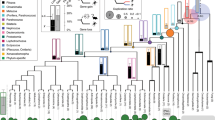Abstract
Early vertebrate evolution is characterized by a significant increase of organismal complexity over a relatively short time span. We present quantitative evidence for a high rate of increase in morphological complexity during early vertebrate evolution. Possible molecular evolutionary mechanisms that underlie this increase in complexity fall into a small number of categories, one of which is gene duplication and subsequent structural or regulatory neofunctionalization. We discuss analyses of two gene families whose regulatory and structural evolution shed light on the connection between gene duplication and increases in organismal complexity.
Similar content being viewed by others
References
Ahn, S. and Tanksley, S.D. (1993) Linkage maps of the rice and maize genomes. Proc. Natl. Acad. Sci. USA, 90, 7980-7984.
Adachi, J. and Hasegawa, M. (1992) MOLPHY, Programs for Molecular Phylogenetics, I. PROTML, Maximum Likelihood Inference of Protein Phylogeny (Computer Science Monographs, Vol. 27). Institute of Statistical Mathematics, Tokyo, Japan
Allendorf, F.W. and Utter, F.M., (1976) Gene duplication in the family Salmonidae. III. Linkage between two duplicated loci coding for aspartate aminotransferase in the cutthroat trout (Salmo clarki). Hereditas, 82, 19-24.
Amores, A., Force, A., Yan, Y.-L., Joly, L., Amemiya, C., Fritz, A., Ho, R.K., Langeland, J., Prince, V., Wang, Y.-L. et al. (1998) Zebrafish hox clusters and vertebrate genome evolution. Science, 282, 1711-1714.
Asano, M. and Gruss, P. (1992) Pax?5 is expressed at the midbrain-hindbrain boundary during mouse development. Mech. Dev., 39, 29-39.
Baker C.V.H. and Bronner-Fraser M. (1997a) The origins of the neural crest. Part I: Embryonic induction. Mech. Dev., 69, 13-29.
Baker, C.V.H. and Bronner-Fraser, M. (1997b) The origins of the neural crest. Part II: An evolutionary perspective. Mech. Dev., 69, 3-11.
Bouchard, M., Pfeffer, P. and Busslinger, M. (2000) Functional equivalence of the transcription factors Pax2 and Pax5 in mouse development. Development, 127, 3703-3713.
Doyle, J.J., Doyle, J.L., Brown, A.H. and Grace, J.P. (1990) Multiple origins of polyploids in the Glycine tabacina complex inferred from chloroplast DNA polymorphism. Proc. Natl. Acad. Sci. USA, 87, 714-717.
Gale, M.D. and Devos, K.M. (1997) Comparative genetics in the grasses Proc. Natl. Acad. Sci. USA, 95, 1971-1974.
Ganter, B. and Lipsick, J.S. (1999) Myb and oncogenesis. Adv. Cancer Res., 76, 21-60.
Gibson, T.J. and Spring, J. (2000) Evidence in favour of ancient octaploidy in the vertebrate genome. Biochem. Soc. Trans., 28, 259-264.
Gilbert, S.F. and Raunio, A.M. (1997) Embryology, Sinauer, Sunderland, MA.
Heller, N. and Brändli, A.W. (1999) Xenopus Pax?2/5/8 orthologues: novel insights into Pax gene evolution and identification of Pax?8 as the earliest marker for otic and pronephric cell lineages. Dev. Genet., 24, 208-219.
Holland P.W.H. (1996) Molecular biology of lancelets: insights into development and evolution. Israel J. Zool., 42, 247-272.
Hughes, A.L. (1999) Phylogenies of developmentally important proteins do not support the hypothesis of two rounds of genome duplication early in vertebrate history. J. Mol. Evol., 48, 565-576.
Kardong, K.V. (1997) Vertebrates, 2nd ed., McGraw-Hill, New York, NY.
Kobel, H.R. and Du Pasquier, L. (1986) Genetics of polyploid Xenopus. Trends Genet., 2, 310-315.
Kozmik, Z., Holland, N.D., Kalousova, A., Paces, J., Schubert, M. and Holland, L.Z. (1999) Characterization of an amphioxus paired box gene, AmphiPax2/5/8: developmental expression patterns in optic support cells, nephridium, thyroid-like structures and pharyngeal gill slits, but not in the midbrain-hindbrain boundary region. Development, 126, 1295-1304.
Maddison, D.R. and Maddison, W.P. (2001) Mac Clade Version 4.0, Sinauer, Sunderland, MA.
Martin, A. (2001) Is tetralogy true? Lack of support for the 'oneto-four rule'. Mol. Biol. Evol., 18, 89-93.
Meyer, A. and Schartl, M. (1999) Gene and genome duplications in vertebrates: the one-to-four (-to-eight in fish) rule and the evolution of novel gene functions. Curr. Opin. Cell Biol., 11, 699-704.
Millet, S., Bloch-Gallego, E., Simeone, A. and Alvarado-Mallart, R.M. (1996) The caudal limit of Otx2 gene expression as a marker of the midbrain/hindbrain boundary: a study using in situ hybridisation and chick/quail homotopic grafts. Development, 122, 3785-3797.
Murphy, P. and Hill, R.E. (1991) Expression of the mouse labiallike homeobox-containing genes, Hox 2.9 and Hox 1.6, during segmentation of the hindbrain. Development, 111, 61-74.
Pfeffer, P.L., Gerster, T., Lun, K., Brand, M. and Busslinger, M. (1998) Characterization of three novel members of the zebrafish Pax2/5/8 family: dependency of Pax5 and Pax8 expression on the Pax2.1 (noi) function. Development, 125, 3063-3074.
Pfeffer, P.L., Payer, B., Reim, G., di Magliano, M.P. and Busslinger, M. (2002) The activation and maintenance of Pax2 expression at the mid-hindbrain boundary is controlled by separate enhancers. Development, 129, 307-318.
Pough, F.H., Janis, C.M. and Heiser J.B. (1999) Vertebrate Life, 5th ed., Prentice Hall, Upper Saddle River, NJ.
Shimeld, S.M. and Holland, P.W.H. (2000) Vertebrate innovations. Proc. Natl. Acad. Sci. USA, 97, 4449-4452.
Sidow, A. (1996) Gen(om)e duplications in the evolution of early vertebrates. Curr. Opin. Genet. Dev., 6, 715-22.
Simon, A.L., Stone, E.A. and Sidow, A. (2002) Inference of functional regions in proteins by quantification of evolutionary constraints. Proc. Natl. Acad. Sci. USA, 99, 2912-2917.
Spring, J. (1997) Vertebrate evolution by interspecific hybridisation— are we polyploid? FEBS Lett., 400, 2-8.
Wada, H., Saiga, H., Satoh, N. and Holland, P.W. (1998) Tripartite organization of the ancestral chordate brain and the antiquity of placodes: insights from ascidian Pax?2/5/8, Hox and Otx genes. Development, 125, 1113-1122.
Wolfe, K.H. and Shields, D.C. (1997) Molecular evidence for an ancient duplication of the entire yeast genome. Nature, 387, 708-713.
Author information
Authors and Affiliations
Rights and permissions
About this article
Cite this article
Aburomia, R., Khaner, O. & Sidow, A. Functional evolution in the ancestral lineage of vertebrates or when genomic complexity was wagging its morphological tail. J Struct Func Genom 3, 45–52 (2003). https://doi.org/10.1023/A:1022648729770
Issue Date:
DOI: https://doi.org/10.1023/A:1022648729770




